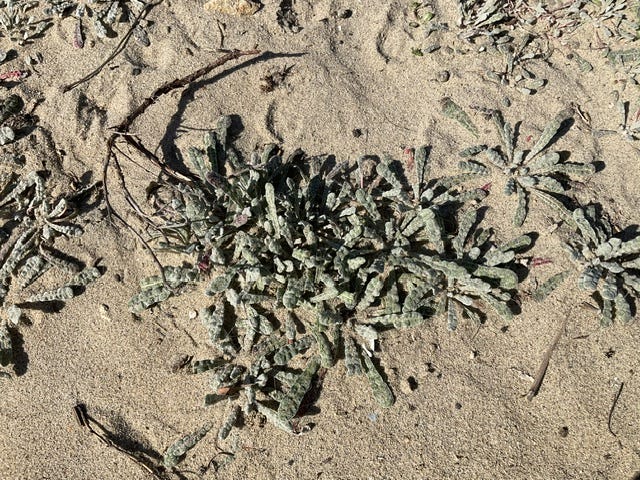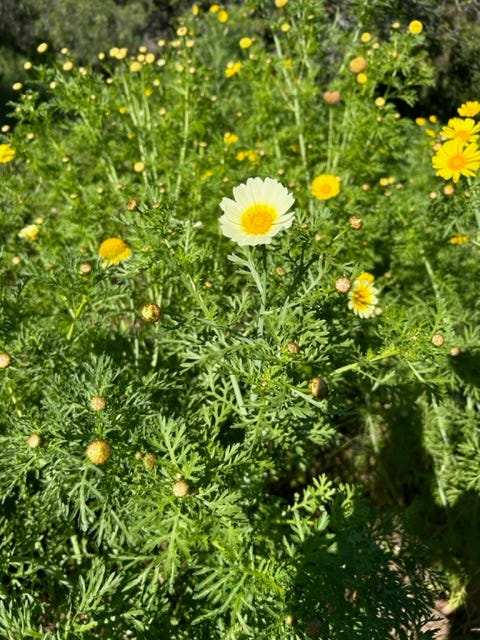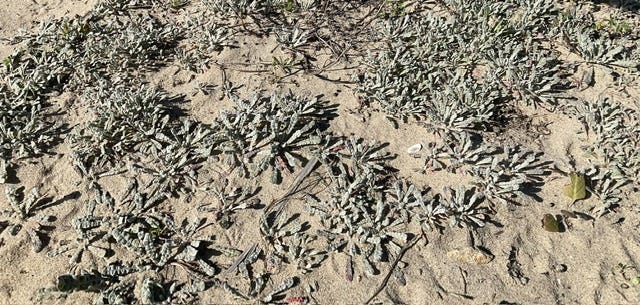“George, over here, let me show you.” I was pretty excited. George and I had just completed a plant survey of a stretch of land that lies north of the zoo where I work. Our task had been to find out how much nonnative iceplant had invaded the area, which we found plenty of. And while most of the plants we had surveyed that day were native, they were mostly species commonly found along the coast of Southern California: salt grasses, pickleweed, with occasional salty Susan, and seablight. Nice native plants, but nothing to get excited about.
What I was now delighted to find was a small, low-lying plant: a woollyhead (Nemacaulus denudata). Woollyheads are cute. With their grey-green, crinkly leaves, they appear to be the result of a school paper mache art project. I found only one that day, and it was right in the line of tire tracks, so its chances of survival were, well, pretty slim.

All the plants I’ve written about in the In touch series have been species I’ve worked with in some way: propagating them, planting them, trimming or pruning them in my gardening work. I’ve done none of that with woollyheads. Nonetheless, about ten years ago, I volunteered for conservation work through the San Diego River Park Foundation. Most of my volunteering was at the estuary where the San Diego River meets the Pacific Ocean and where you can find woollyheads.
Last week, I visited the estuary with my friend Dave. The estuary is home to at least three rare and endangered species, woollyheads among them. I was happy that Dave and I discovered whole areas blanketed with woollyheads.
Woollyheads are members of the Buckwheat plant family. In a few weeks, these little annual plants will spread long, thin inflorescences that bear their flowers and seeds, a characteristic common to many species of buckwheat. These inflorescences cross and recross each other, creating rectangles, triangles, and other such shapes, which is where the scientific name of the family, Polygonaceae, comes from. Buckwheat is, of course, the grain that we like to make pancakes from. Rhubarb is also in the buckwheat family.
Woollyheads are the only species in the Nemacaulis genus. Botanists recognize two varieties: coast woolly-heads and slender cottonheads. The ones I see at the estuary are the coast woolly-heads (I’m pretty sure of that). While the slender cottonheads can be found along the coast, they also thrive in California deserts around Indio, Anza-Borrego State Park, and east of Joshua Tree National Park.
The California Native Plant Society classifies the coast woolley-heads as 1B.2, meaning they considered rare, threatened, or endangered in California and elsewhere. The slender cottonheads are classified as 2B.2; that is, rare, threatened, or endangered in California, yet common elsewhere.
There aren’t a whole bunch of woollyheads. They have always been limited in geography and habitat, making them rare in the first place. Here, along the coast, much of their habitat has been turned into marinas and beachfront property. The sandy dunes they favor are also favorite places where people like to walk around and sun themselves.
In Ocean Beach, the neighborhood next to the San Diego River estuary, the woollyheads grow adjacent to a popular dog park, Dog Beach, where folks can let their dogs off leash. Although the length of a football field separates the dog park from the woollyheads habitat, folks still allow their dogs to roam free through the area. Lots of unleashed dogs trample the habitat. Ocean Beach is also a neighborhood in which the 1960s remain a way of life. You can still live like a hippie in this enclave. That leads to a lot of free-spirited folks sleeping openly on the beach and habitat.
When I was involved with preservation at the estuary, the habitat had been invaded in a few areas by nonnative grasses, but not much else. When I visited the estuary last week, crown daisy, a highly invasive plant from Europe, had taken over some spaces of the estuary. If nothing is done, crown daisies could easily take over the entire area in a few years.

The estuary has roped off hiking paths, but folks still walk where they shouldn’t and trample the woollyheads and other plants. There are signs that remind visitors to stay on the paths and that the roped-off places are protected habitat, but no signs indicate that the plants they might squash underfoot are rare or endangered. Sometimes when visiting the estuary, I’ve angered dog owners by asking them to leash their pets and keep them on the pathways.
In my opinion, the city of San Diego and the state of California could do a lot more to ensure that this endangered species isn’t trampled. They could at least put up some signage to let folks know that the woollyheads they have been asked not to step on are rare and endangered. Do you have any suggestions that might ensure the woollyheads have a place to live undisturbed?





